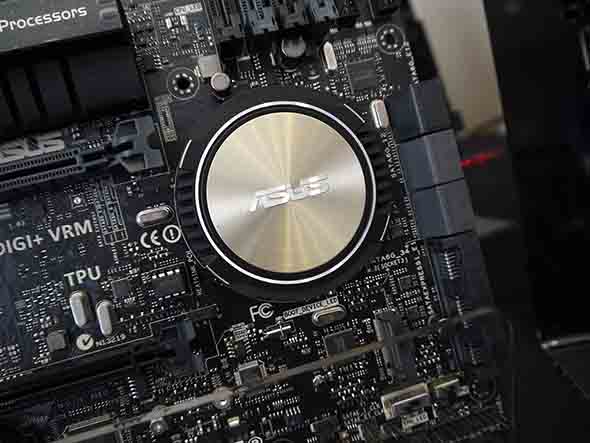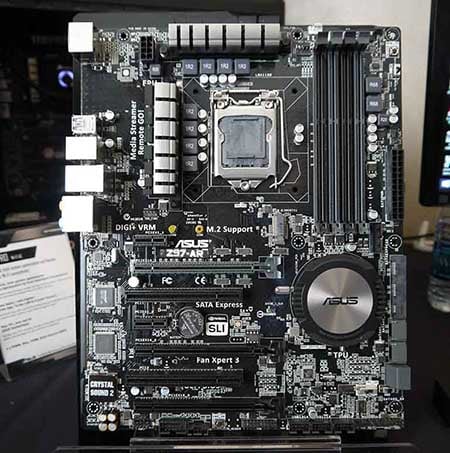ASUS Previews Full Spate Of Z97 Motherboards
It’s that time of year again folks, and we’ve been getting some previews of the hot new motherboards coming down the pike. We already discussed what Gigabyte has in store, but ASUS gave us the grand tour of their new, extensive lineup of Z97 motherboards.
We’re talking the whole socket LGA 1150 schmeer here, from mainstream boards to deluxe models to ROG gaming boards to the TUF and workstation models.
First off, I have to say that ASUS’ deluxe and mainstream motherboards are just about the prettiest I’ve ever seen. Those pewter-ish accents look superb in person--metallic and cool without being ostentatious--and just look at those circular southbridge heatsinks.
The Z97-Deluxe, as expected, comes loaded with choice features such as DisplayPort, an onboard dual-band WiFi 802.11ac (plus BT 4.0) module, dual gigabit LAN, and 8-channel audio with DTS support and special audio channel shielding to deliver optimal sound quality with as little interference as possible.
There’s a 10Gbps M.2 socket, dual 10Gbps SATA Express, a TPU header, PCIe 3.0 (Gen 3) that supports four-way SLI and CrossFireX graphics cards, and it supports DDR3-3000 (OC) memory (with four DIMM slots).
ASUS is actually rolling out two versions of the Z97-Deluxe; both have all the features mentioned above, but the second Deluxe model sports NFC Express 2 and wireless charging capabilities (powered by Qi technology), too.
The rest of the channel includes the Z97-Pro--again, there are two Pro models, one with that same WiFi module mentioned above and one without--as well as the Z97-A, Z97-AR, and diminutive Z97-I Plus.
Although not all the above motherboards boast all the same specs and features of the Deluxe, they do mostly enjoy the platform-wide benefits of the freshly gussied-up UEFI and its features.
There’s a new EZ mode with an EZ Tuning Wizard for novice overclockers who like to work within the BIOS instead of a Windows environment as well as a RAID Wizard designed to make setting up a RAID configuration as easy as possible. You can create “MyFavorites” settings in the UEFI to make it easier to get to your most frequently-used BIOS settings, and a new boot setting allows you to boot into the BIOS without clacking like a maniac on the delete key.
We’re now up to Dual Intelligent Processors with 5-way optimization and even deeper granular control over items such as fan settings. ASUS added some capabilities with Turbo APP, which allows you to set overclocking profiles for individual applications, as well as a feature that enables you to pair a smartphone or tablet to an application and receive alerts if, for example, the fans stop running.
ASUS also cooked up something called ASUS Home Cloud, which seems to be quite a bit like the WD My Cloud products. Basically, it allows remote access to and control over your data; there’s even a media streaming feature so you can share photos, video, and music on your mobile devices, other computers, or TVs.
ASUS has a set of lookers on its hands with its new ROG line, which has reach the Maximus VII generation. There are six SKUs in all: an Extreme board (although that one may not end up being a real thing), Formula (ATX), Hero (ATX), Gene (mATX), Impact (mini-ITX), and a new ITX board dubbed “Ranger” (pictured here).
Among the hardware features you can expect on these boards are support for quad-channel DDR3-3200 (OC), multi-GPU support with PCIe 3.0, an M.2 port, Intel Ethernet chips, SupremeFX 2014 audio with gold-plated audio jacks, and numerous FanXpert III headers. There’s also OC Panel support on the boards thanks to an ROG_EXT headers, and there are plenty of onboard buttons, which include start and reset, MemOK! to check memory, and KeyBot. The KeyBot button allows you to create a DirectKey command to boot directly into the UEFI, create macro keys and folder shortcuts, and more. (It’s actually quite a powerful tool.)
In addition to using Intel networking hardware, ASUS baked in GameFirst III packet priority control, which in a nutshell prioritizes game network packets over non-game packets. This can actually be mapped to any connected networking device, and there’s a handy network monitoring interface and LANGuard surge protection, too.
ASUS has taken great pride in detailing the build quality of its Z97 ROG motherboards. They’ve implemented 10k black metallic capacitors, DRAM over-current protection, better ESD guards, thermal pads on the backplates, stainless steel rear I/O panel, and one-clip Q-slots for more easily removing GPUs and DIMMs.
In terms of software, ASUS loaded the boards with pretty much what we’ve seen before: ROG CPU-Z, Mem TewakIt, Secure Erase, RamDisk, AI Suite 3, USB BIOS Flashback, and more.
ASUS also showed us their new TUF and workstation motherboards. These enjoy many of the same Z97 platform features that their brethren do. The TUF boards enjoy the same 10k black caps and extensive ESD guard protection as the ROG series, and they also feature alloy chokes and military-standard MOSFETs.
Other features include TUF Fortifier, a backplate that adds rigidity while also acting as another heatsink and Thermal Armor with dust resistant fans (that can reverse and blow out dust). Thermal Radar 2 offers new detection points on the VGA and fan control.
TUF Ice is a whale of a new feature; it’s a separate microprocessor embedded on the motherboard that handles thermal management, system monitoring, and so on to take some of the burden off of the CPU. The new TUF boards also feature SATA Express.
The two TUF boards, the Sabertooth Z97 Mark 1 and Mark 2, sport decidedly militaristic themes. The thermal armor is metallic-looking, the heatsinks are dressed in desert camo, and all the ports and slots are decked out in tans and browns, too. ASUS also set up their TUF display in this superb olive drab chassis, which we wouldn’t mind owning someday.
Stay tuned for reviews on ASUS’ Z97 motherboards (and those from their competitors) in the not-too-distant future.
We’re talking the whole socket LGA 1150 schmeer here, from mainstream boards to deluxe models to ROG gaming boards to the TUF and workstation models.
First off, I have to say that ASUS’ deluxe and mainstream motherboards are just about the prettiest I’ve ever seen. Those pewter-ish accents look superb in person--metallic and cool without being ostentatious--and just look at those circular southbridge heatsinks.
The Z97-Deluxe, as expected, comes loaded with choice features such as DisplayPort, an onboard dual-band WiFi 802.11ac (plus BT 4.0) module, dual gigabit LAN, and 8-channel audio with DTS support and special audio channel shielding to deliver optimal sound quality with as little interference as possible.
There’s a 10Gbps M.2 socket, dual 10Gbps SATA Express, a TPU header, PCIe 3.0 (Gen 3) that supports four-way SLI and CrossFireX graphics cards, and it supports DDR3-3000 (OC) memory (with four DIMM slots).
ASUS is actually rolling out two versions of the Z97-Deluxe; both have all the features mentioned above, but the second Deluxe model sports NFC Express 2 and wireless charging capabilities (powered by Qi technology), too.
The rest of the channel includes the Z97-Pro--again, there are two Pro models, one with that same WiFi module mentioned above and one without--as well as the Z97-A, Z97-AR, and diminutive Z97-I Plus.
Although not all the above motherboards boast all the same specs and features of the Deluxe, they do mostly enjoy the platform-wide benefits of the freshly gussied-up UEFI and its features.
There’s a new EZ mode with an EZ Tuning Wizard for novice overclockers who like to work within the BIOS instead of a Windows environment as well as a RAID Wizard designed to make setting up a RAID configuration as easy as possible. You can create “MyFavorites” settings in the UEFI to make it easier to get to your most frequently-used BIOS settings, and a new boot setting allows you to boot into the BIOS without clacking like a maniac on the delete key.
We’re now up to Dual Intelligent Processors with 5-way optimization and even deeper granular control over items such as fan settings. ASUS added some capabilities with Turbo APP, which allows you to set overclocking profiles for individual applications, as well as a feature that enables you to pair a smartphone or tablet to an application and receive alerts if, for example, the fans stop running.
ASUS also cooked up something called ASUS Home Cloud, which seems to be quite a bit like the WD My Cloud products. Basically, it allows remote access to and control over your data; there’s even a media streaming feature so you can share photos, video, and music on your mobile devices, other computers, or TVs.
ASUS has a set of lookers on its hands with its new ROG line, which has reach the Maximus VII generation. There are six SKUs in all: an Extreme board (although that one may not end up being a real thing), Formula (ATX), Hero (ATX), Gene (mATX), Impact (mini-ITX), and a new ITX board dubbed “Ranger” (pictured here).
Among the hardware features you can expect on these boards are support for quad-channel DDR3-3200 (OC), multi-GPU support with PCIe 3.0, an M.2 port, Intel Ethernet chips, SupremeFX 2014 audio with gold-plated audio jacks, and numerous FanXpert III headers. There’s also OC Panel support on the boards thanks to an ROG_EXT headers, and there are plenty of onboard buttons, which include start and reset, MemOK! to check memory, and KeyBot. The KeyBot button allows you to create a DirectKey command to boot directly into the UEFI, create macro keys and folder shortcuts, and more. (It’s actually quite a powerful tool.)
In addition to using Intel networking hardware, ASUS baked in GameFirst III packet priority control, which in a nutshell prioritizes game network packets over non-game packets. This can actually be mapped to any connected networking device, and there’s a handy network monitoring interface and LANGuard surge protection, too.
ASUS has taken great pride in detailing the build quality of its Z97 ROG motherboards. They’ve implemented 10k black metallic capacitors, DRAM over-current protection, better ESD guards, thermal pads on the backplates, stainless steel rear I/O panel, and one-clip Q-slots for more easily removing GPUs and DIMMs.
In terms of software, ASUS loaded the boards with pretty much what we’ve seen before: ROG CPU-Z, Mem TewakIt, Secure Erase, RamDisk, AI Suite 3, USB BIOS Flashback, and more.
ASUS also showed us their new TUF and workstation motherboards. These enjoy many of the same Z97 platform features that their brethren do. The TUF boards enjoy the same 10k black caps and extensive ESD guard protection as the ROG series, and they also feature alloy chokes and military-standard MOSFETs.
Other features include TUF Fortifier, a backplate that adds rigidity while also acting as another heatsink and Thermal Armor with dust resistant fans (that can reverse and blow out dust). Thermal Radar 2 offers new detection points on the VGA and fan control.
TUF Ice is a whale of a new feature; it’s a separate microprocessor embedded on the motherboard that handles thermal management, system monitoring, and so on to take some of the burden off of the CPU. The new TUF boards also feature SATA Express.
The two TUF boards, the Sabertooth Z97 Mark 1 and Mark 2, sport decidedly militaristic themes. The thermal armor is metallic-looking, the heatsinks are dressed in desert camo, and all the ports and slots are decked out in tans and browns, too. ASUS also set up their TUF display in this superb olive drab chassis, which we wouldn’t mind owning someday.
Stay tuned for reviews on ASUS’ Z97 motherboards (and those from their competitors) in the not-too-distant future.













